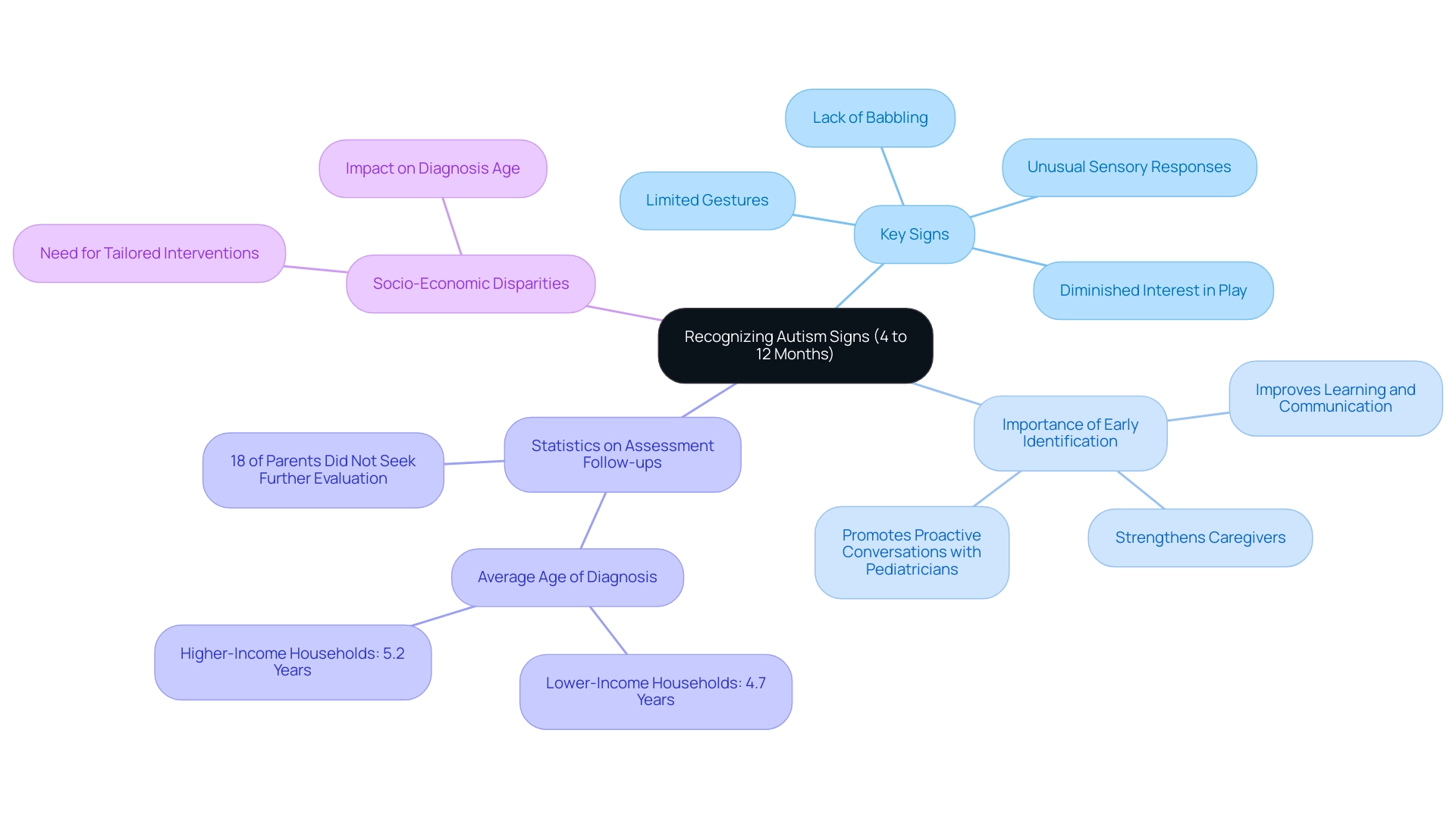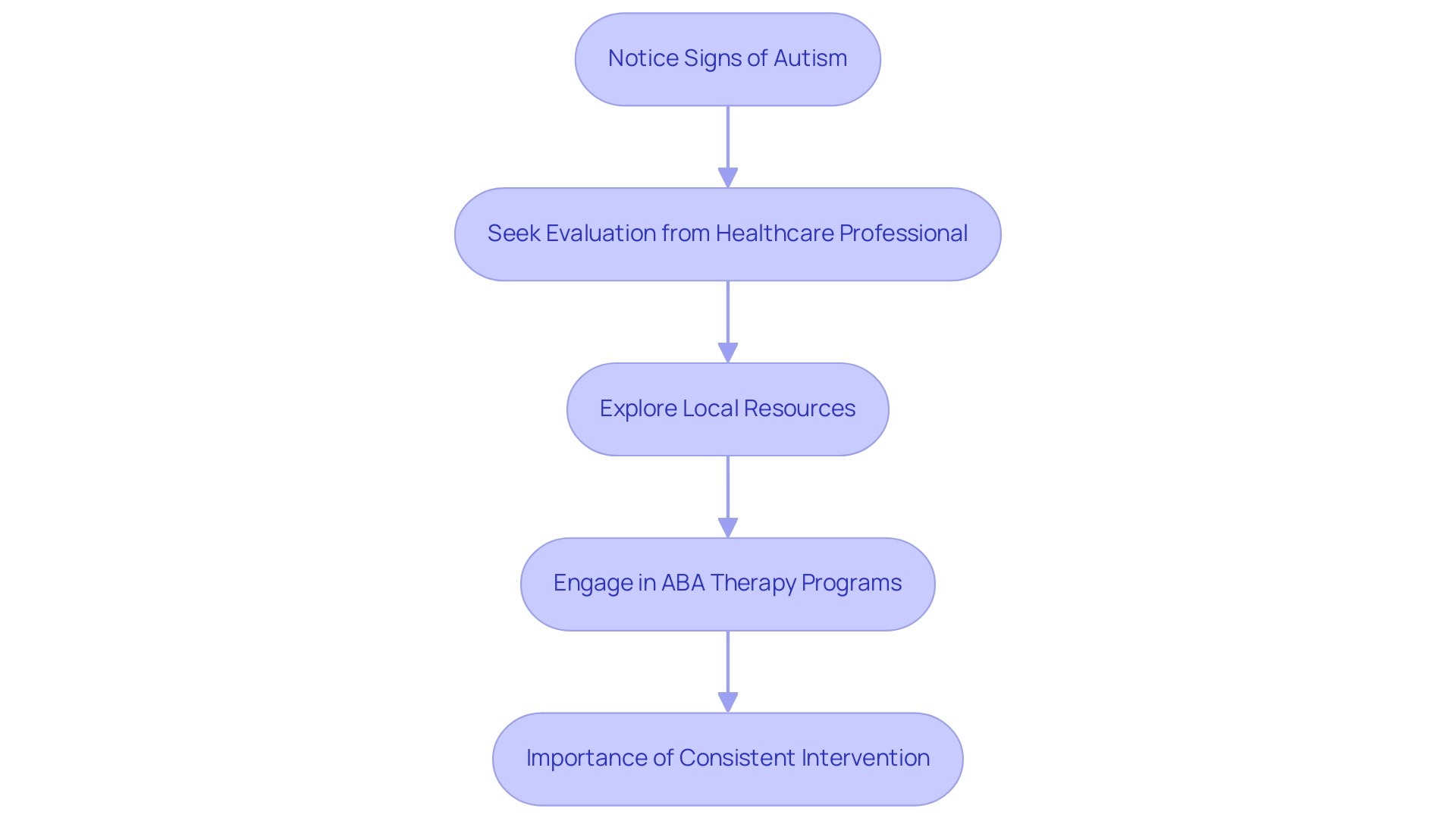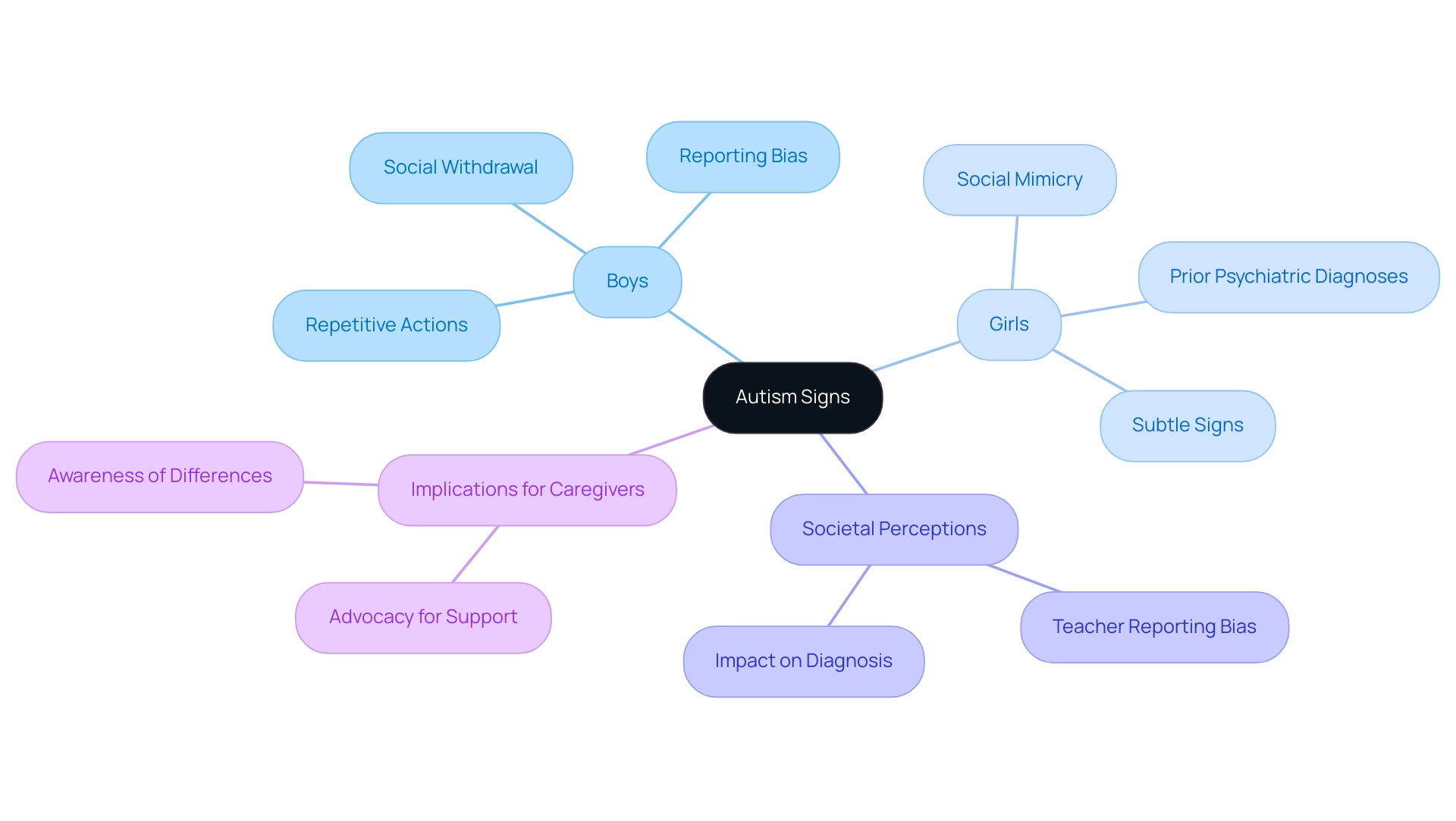Overview
The article focuses on identifying key baby signs of autism that every parent should be aware of to facilitate early detection and intervention. It emphasizes that signs such as limited eye contact, lack of response to their name, and reduced interest in social engagement are critical indicators that can help parents advocate for timely assessments and support, ultimately improving outcomes for children with Autism Spectrum Disorder.
Introduction
Navigating the complexities of Autism Spectrum Disorder (ASD) can be a daunting journey for parents, filled with questions and uncertainties. Understanding the intricacies of autism is essential, as early recognition and intervention can profoundly influence a child's development and well-being.
With rising statistics highlighting the prevalence of autism, parents must equip themselves with knowledge about the key signs and indicators that may emerge at various stages of their child's growth. From the subtle cues observed in infants to the more pronounced behaviors noticed in toddlers, being vigilant and informed can empower parents to take proactive steps toward securing the support and resources their children need.
This article serves as a comprehensive guide, offering insights into the signs of autism, the importance of early intervention, and the unique ways autism may manifest in boys and girls, ultimately fostering a path toward understanding and advocacy.
Understanding Autism: An Overview for Parents
Autism Spectrum Disorder (ASD) is a complex developmental disorder marked by challenges in social interaction, communication, and the presence of repetitive behaviors. Identifying and comprehending the baby signs of autism and other developmental disorders is essential for parents, as prompt detection can greatly affect a young person's growth path. Current statistics indicate a rising prevalence of the condition, with recent assessments incorporating Medicaid healthcare claims data to provide a clearer picture of ASD among youth.
Significantly, studies indicate that some youngsters display prominent baby signs of autism in their early years, while others may follow a more standard development trajectory before showing signs of the condition later on. This variability highlights the significance of understanding the key indicators of the condition, including:
- Baby signs of autism
- Difficulties in engaging with others
- Challenges in communication
Additionally, it's important to recognize that 36.5% of autism caregivers utilize ABA therapy for their dependent, highlighting a common intervention strategy.
Parents of autistic individuals often experience more stress than those with neurotypical individuals, influenced by various factors including individual characteristics and social support. By empowering yourself with this knowledge, you can advocate for early intervention and support, ensuring your offspring receives the resources they need to thrive. Furthermore, the evolution of symbols used in advocacy for this condition, like the transition from the puzzle piece to the rainbow infinity sign, reflects a growing understanding and representation of the condition, which is vital for fostering inclusion.
Keep in mind, as a caregiver, your understanding and proactive strategy are essential in navigating the spectrum and ensuring the best results for your child.
Key Signs of Autism in Infants: 0 to 3 Months
In the first three months of life, parents should be vigilant regarding their infant's interactions with their environment. Key indicators of baby signs of autism may include:
- Limited eye contact
- A lack of response to their name
- A reduced interest in social engagement, such as smiling or cooing
Research indicates that 42% of infants identified with autism spectrum disorder (ASD) display asymmetrical tonic neck reflex (ATNR) positions, which are significantly different from the 19% observed in the language (EL) non-ASD group and 20% in the typical language (TL) non-ASD group.
Additionally, 16.6% of infants in the non-ASD group also display atypical positions, highlighting the importance of recognizing these behaviors in context. While it’s common for infants to display a range of behaviors, consistent and concerning patterns may be recognized as baby signs of autism, indicating a need for further evaluation. Dr. Sara Jane Webb from the University of Washington highlights that studying very initial development may thus enable sooner detection and intervention for individuals with ASD and their families.
The analysis by Rosenberg et al. on initial intervention eligibility versus service rates under Part C of the Individuals with Disabilities Education Act underscores the critical nature of prompt detection. Moreover, the American Academy of Neurology and Child Neurology's suggestion in 2000 to assess all youngsters for spectrum disorder emphasizes the importance of timely recognition.
Parents are encouraged to closely monitor their child's developmental milestones for baby signs of autism and engage with healthcare professionals if they observe any troubling signs, ensuring that any concerns are addressed promptly.
Recognizing Autism Signs from 4 to 12 Months
As infants grow and develop between the ages of 4 to 12 months, it becomes essential for caregivers to watch for baby signs of autism. Key signs of baby signs of autism include:
- A noticeable lack of babbling
- Limited gestures, such as pointing or waving, which are essential for initial communication
Furthermore, caregivers may observe their infants showing diminished interest in interactive play, which is essential for social development.
Unusual sensory responses, such as overreacting to sounds or textures, can also signal the need for further evaluation. Significantly, studies show that 18% of guardians did not pursue additional assessment following a positive screening, emphasizing the significance of prompt identification and intervention. Moreover, the typical age of identification for youngsters in lower-income families is 4.7 years in contrast to 5.2 years in higher-income families, highlighting disparities in diagnosis and the necessity for prompt intervention.
Identifying baby signs of autism promptly not only strengthens caregivers but also promotes proactive conversations with pediatricians. A case study titled 'Social Interaction Impairments in Toddlers with ASD' illustrates that toddlers with ASD exhibit reduced attention to social stimuli, emphasizing that social impairments are central to the diagnosis of ASD. Early intervention is crucial, as studies indicate that prompt assessments and actions can greatly improve learning, communication, and social abilities in young individuals with ASD.

Taking Action: Early Intervention Strategies for Parents
When parents notice baby signs of autism, taking swift action is crucial. Engaging in early intervention can profoundly enhance a young person's developmental trajectory and overall quality of life. Seeking an evaluation from a qualified healthcare professional or developmental specialist is a vital first step.
Additionally, exploring local resources, such as support groups and ABA therapy programs, can provide tailored strategies that address an individual's unique needs. As Fayge Orzel aptly states,
Discover ABA therapy intervention techniques that empower growth and learning for individuals of all ages.
This approach not only provides caregivers with essential tools but also connects them with professionals who specialize in autism, guiding them through the complexities of diagnosis and support planning.
Research indicates that initial intervention strategies can lead to significant improvements in recognizing baby signs of autism, as supported by the systematic review and meta-analysis by Maw and Haga (2018), which evaluated the effectiveness of cognitive, developmental, and behavioral interventions for preschool-aged children with Autism Spectrum Disorder. However, it's concerning that 66% of families report receiving less than the recommended 25 hours of intervention weekly, with most relying heavily on applied behavior analysis (averaging 16.2 hours). This statistic highlights the significance of sufficient support, emphasizing the necessity for caregivers to prioritize initial assessment and intervention.
A compelling real-life example is the case of Ethan, diagnosed with autism at two years old, who displayed baby signs of autism, including severe tantrums and communication challenges. His enrollment in an ABA-based intervention program, which included speech therapy and caregiver training, marked a turning point; within a year, Ethan reduced his tantrums by 70% and began using short phrases, eventually participating in group activities at preschool. By prioritizing early assessment and intervention, guardians can help ensure their offspring receive the support they need to flourish.

Do Autism Signs Differ Between Boys and Girls?
Research indicates that spectrum disorder (ASD) often presents differently in boys and girls, with girls frequently showing subtle signs that can be easily overlooked. While boys may exhibit more pronounced behaviors such as repetitive actions or social withdrawal, girls might engage in social mimicry, which can mask their symptoms and lead to a delay in diagnosis. This disparity emphasizes the necessity for guardians to be keenly aware of these differences when assessing their offspring's behavior.
A recent systematic review of research on gender differences in developmental disorders underscores the importance of recognizing these variations, revealing that females are more likely to have received prior psychiatric diagnoses compared to males. Furthermore, teachers are more likely to report atypicality for males diagnosed with ASD, which illustrates societal perceptions and reporting biases that can influence diagnosis. Recognizing that autism can present differently in every individual not only empowers caregivers but also motivates them to be proactive in seeking the necessary support.
As Emily Cassanova points out,
We see a lot of these overlapping chronic health conditions that by and large affect women more anyways...
This awareness can help parents advocate effectively for their children, ensuring they receive the appropriate resources tailored to their specific needs, regardless of gender.

Conclusion
Understanding Autism Spectrum Disorder is a vital journey for parents, marked by the need for vigilance and proactive engagement. The article highlights the importance of early detection, illustrating how recognizing key signs—from limited eye contact in infants to social engagement challenges in toddlers—can significantly influence a child's developmental path. Moreover, the discussion on gender differences in autism presentation emphasizes the necessity for parents to be aware of the subtleties that may arise, particularly in girls, who may exhibit less overt symptoms.
Taking action through early intervention strategies is crucial for fostering positive outcomes. Seeking evaluations and utilizing resources such as ABA therapy can empower parents and provide essential support tailored to their child’s unique needs. The statistics regarding intervention hours underscore the urgency for families to prioritize these services, ensuring their children receive the comprehensive support necessary for growth and development.
Ultimately, the journey through autism advocacy is one of empowerment and understanding. By equipping themselves with knowledge and resources, parents can effectively navigate the complexities of Autism Spectrum Disorder, advocating for their children’s needs and fostering an environment where they can thrive. This proactive approach not only supports the child’s development but also strengthens the family unit, creating a foundation for a brighter future.
Frequently Asked Questions
What is Autism Spectrum Disorder (ASD)?
Autism Spectrum Disorder (ASD) is a complex developmental disorder characterized by challenges in social interaction, communication, and the presence of repetitive behaviors.
Why is it important for parents to recognize baby signs of autism?
Recognizing baby signs of autism is essential for parents because prompt detection can significantly influence a young person's developmental trajectory and access to early intervention resources.
What are some common early signs of autism in infants?
Common early signs of autism in infants include limited eye contact, lack of response to their name, and reduced interest in social engagement, such as smiling or cooing.
What percentage of infants with ASD show asymmetrical tonic neck reflex (ATNR) positions?
Research indicates that 42% of infants identified with ASD display asymmetrical tonic neck reflex (ATNR) positions, compared to 19% in the language non-ASD group and 20% in the typical language non-ASD group.
How do caregivers of autistic individuals experience stress compared to those with neurotypical children?
Caregivers of autistic individuals often experience more stress than those with neurotypical children, influenced by various factors such as individual characteristics and levels of social support.
What intervention strategy is commonly used by caregivers of autistic children?
Approximately 36.5% of autism caregivers utilize Applied Behavior Analysis (ABA) therapy as a common intervention strategy.
What should parents do if they observe concerning signs in their child's development?
Parents should closely monitor their child's developmental milestones for baby signs of autism and engage with healthcare professionals if they notice any troubling signs to ensure prompt evaluation and support.
What is the significance of the symbols used in autism advocacy?
The evolution of symbols in autism advocacy, from the puzzle piece to the rainbow infinity sign, reflects a growing understanding and representation of the condition, which is vital for fostering inclusion.
What recommendations have been made regarding the assessment of children for autism?
The American Academy of Neurology and Child Neurology recommended in 2000 that all children be assessed for autism spectrum disorder to emphasize the importance of timely recognition and intervention.




